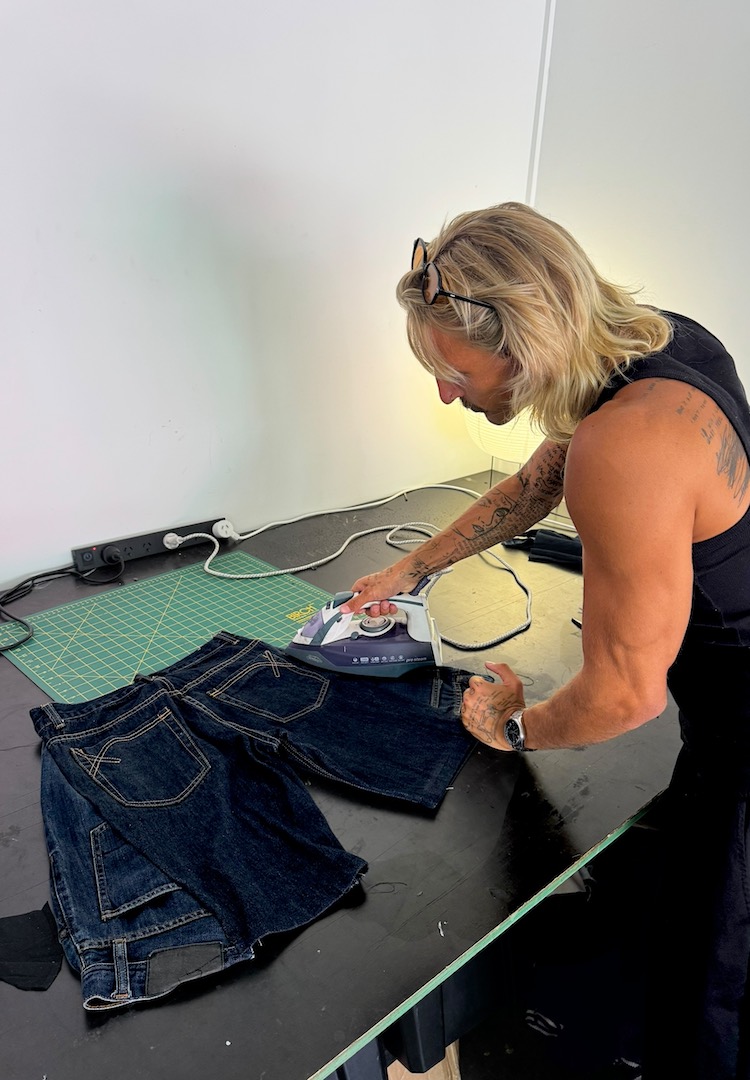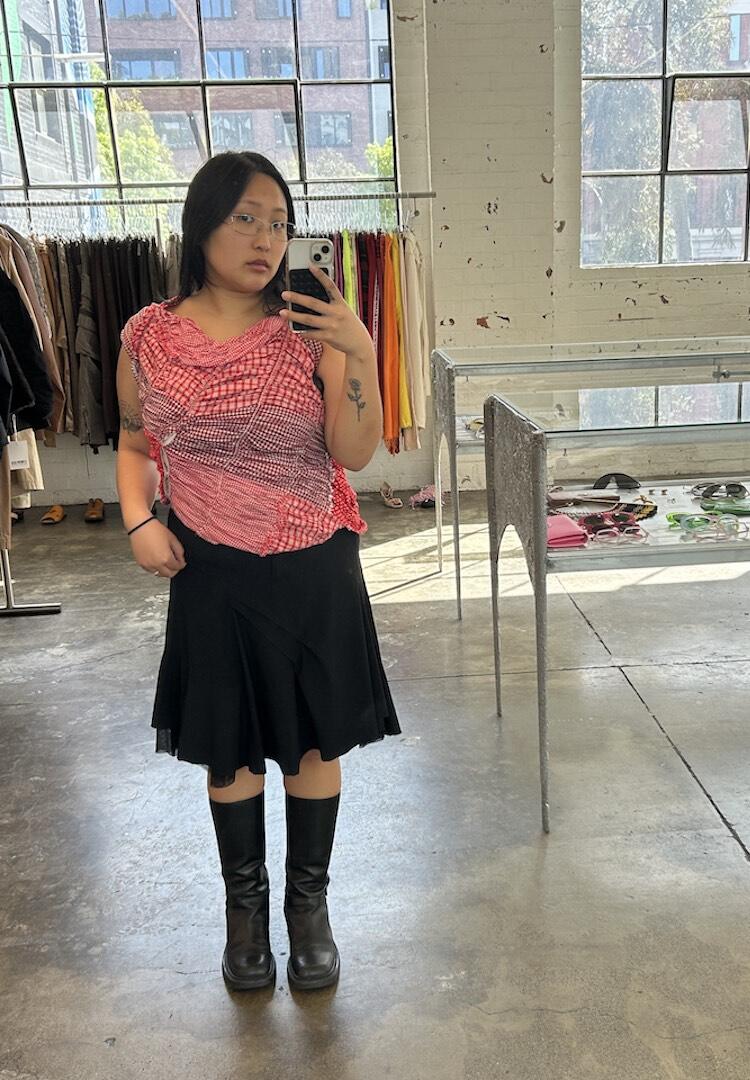9 Australian creatives share how much of their wardrobe is pre-loved
IMAGE VIA @ISABELLACHANTAL/INSTAGRAM
WORDS BY IZZY WIGHT
“When I do shop, it’s either from carefully considered sustainable brands, or it’s thrift store finds.”
With the secondhand fashion market booming, it’s fair to say most of us own at least a few items purchased from an op shop, resale platform or consignment store. The climate crisis is looming (if not already here) and more people are engaging in a circular fashion economy. It seems like a no-brainer – it’s better for the planet, and you get the thrill of hunting for an item nobody else has.
Looking for more fashion news and features? Head to our Fashion section.
But on the flip side, there are now a multitude of local labels making real changes in the sustainable clothing space. While shopping secondhand might feel more rewarding, it’s hard to deny the allure of something brand new. To find out more about how we’re shopping, we asked some of our favourite Australian creatives how much of their wardrobes are pre-loved.
Olivia Mangan, Co-Founder of Goodbyes
View this post on Instagram
At least 95 per cent of my wardrobe is pre-loved [and] it’s been this way for as long as I can remember. Browsing ‘new’ sparks inspiration but I find it difficult to justify the price compared to secondhand. Rather predictably, I believe consignment stores are the best way to shop. You can discover a unique selection that reflects the local wardrobes of the city, this means I have made some of the best purchases when travelling – like a vintage woven wool and silk trench coat that I bought in Paris.
My shopping approach oscillates between playful experimentation and seeking out enduring wardrobe staples, reflecting a balance of fun and functionality centred around seeking high-quality fabrics. As pre-loved is the default in my wardrobe, perhaps the motivations behind my new purchases reveal more about my habits.
Recently, I bought a bomber jacket from Lova Mohan. It’s a new local label [and] I was keen to invest as a Goodbyes staff member runs it. I saved up for a pair of perfect loafers by The Row – pricey, but I am justifying these with cost-per-wear as they are a timeless shoe. My style is ever-evolving but I’ll be bold and say that you will never catch me wearing head-to-toe new!
Kostantina Vlahos, art director and photographer
View this post on Instagram
Currently, 85 per cent of my wardrobe is pre-loved. I tend to rarely shop so when I do, it’s mainly at local op shops and thrift stores while travelling or rummaging through my aunties’ and uncles’ wardrobes for some cute vintage pieces. I prefer preloved clothes due to the unique one-of-ones I find, along with the sustainable ethos of preloved fashion.
Vintage clothes were built to last and have a better lifespan, allowing me to keep pieces for ages. I am an avid hoarder… and have clothes that go as far back as year eleven, which are the sentimental pieces that I love most. So with trends repeating themselves, I continue to cycle through these garments and give them another life or two.
Giulia Brugliera, Fashion Journal’s Managing Editor
View this post on Instagram
Right now only a very small portion of my wardrobe is pre-loved, I’d say around five per cent. It sounds abysmal, but I tend to only buy a handful of clothes each year, so most of what’s in there I’ve owned for over a decade with a cost-per-wear of almost nothing. I’m a big believer in outfit repeating (ask anyone I see regularly) and am more than comfortable wearing the same item on repeat for years. I’m certainly an anomaly working in the fashion industry, but this approach means I really study and save for the pieces I want.
My general rule is I need to eye an item for three to six months before I purchase. That said, I recently sold a handful of clothes and have kept the money sitting in my PayPal as my fashion budget. I could blow it all on one item but instead have set alerts for my favourite designers online, so if something I’ve been eyeing pops up on the resale market, I can snap it up. It’s a game of patience, but I’m happy to wait.
Robert Baxter, model and performing artist
View this post on Instagram
I have about 30 per cent pre-loved clothes in my wardrobe. It’s a mix of op shop and vintage items, and I’d like to grow that number. As an artist, I borrow clothes where I can, but sometimes I have to buy them for performances, shoots and events. Some items are gifted and I end up giving a lot of things to friends and family.
Jasmin Amma, model
View this post on Instagram
Around 70 per cent of my wardrobe is pre-loved. I enjoy the creativity involved in experimenting with pieces found in op shops, vintage markets and designer consignment stores… The op shop is where my personal style started to form. I think that’s why my wardrobe usually consists of more secondhand items. In the last few years, I have been focused on buying less, holding on to special items and staple pieces, and being more thoughtful about my purchases.
Meg Wilcher, Founder of Après Studio
View this post on Instagram
I have to admit, about 75 per cent of my wardrobe is made up of pre-loved clothing and shoes. If I have been eyeing something off for a while, I generally invest time on platforms such as Vestiare or The RealReal to find the lightly pre-loved item. My bank account is a much bigger fan of a worn-once price drop than an often hefty brand-new price point.
One of my favourite things in the world is spending time fossicking for golden pieces from another age nestled in amongst other donated goods at a thrift store. The Cinderella moment of finding something that fits you perfectly… almost creates an illusive sense of time travel. There is also the layered gratification of knowing that the likelihood of seeing anybody else in that item is low and that it didn’t cost the earth to own it. What can I say? I am a big fan.
Maggie Zhou, writer, podcaster and content creator
View this post on Instagram
I’d say around 70 per cent of my wardrobe is pre-loved. I’d actually say that 90 per cent of what I buy is pre-loved, but I’m very lucky to be in a position where I’m gifted items too. Secondhand shopping is my favourite way of consuming fashion; it’s not only great for the circular economy by keeping clothes out of landfills, but I have access to so many interesting pieces that nicely complement my style.
Most of the time, it’s also cheaper. I used to be a massive op shop fiend (I still am) but find I’m spending more time in consignment shops like Goodbyes and Swop, as well as Depop, nowadays. It’s more convenient and I get to find extra special pieces.
Clare Press, writer, podcaster and the author of Wear Next
View this post on Instagram
I’m guessing around 40 per cent of my wardrobe is secondhand or vintage. Is that a lot? It would be more, except I’ve been amassing clothes for 20 years. While I do on-sell things that don’t suit me anymore, I’ve definitely got quite the collection and many designer pieces I’ve bought new over the years.
These days, however, I’ve massively slowed down my consumption because of my work in sustainability. I rarely buy clothes because I just don’t need any more! But also because I care about the negative impacts of the fashion industry and over-consumption. When I do shop, it’s either from carefully considered sustainable brands, or it’s thrift store finds.
I’ve also taken to ‘fantasy shopping’ in charity shops, where I pick out fantastic pieces I would buy if I could justify it, and just enjoy the hunt without actually taking anything home. It’s made me think: how much of the buzz we get from shopping is actually the thrill of the chase? Or the fun of sharing that with friends? Can we get that fix in other ways?
Bella de Almeida Reis, Marketing Executive at PayPal Melbourne Fashion Festival
View this post on Instagram
My grandma taught me at an early age the importance of buying preloved clothing, taking me around the local op shops on weekends and showing me her best tips on finding hidden treasures. That means my wardrobe is about 60 per cent pre-loved after accumulating it for so many years. While I would love to increase this number, I have a pretty large collection of clothing that I’m hoping to sell before I invest in even more secondhand, so I’m still sustainable in the way I consume.
Regardless, I struggle to turn away a good steal (don’t we all), and if I’m in need of a new staple item, the first spots I go to are Swop, Goodbyes, Vintage Sole, Mutual Muse or any small preloved store in northside Melbourne and regional Victoria when visiting family. What I love most about a preloved piece is its character and story. I will always think about my adored leather jacket that my mum used to wear in her twenties, and it’s almost in perfect condition.
For more on shopping sustainably, head here.













